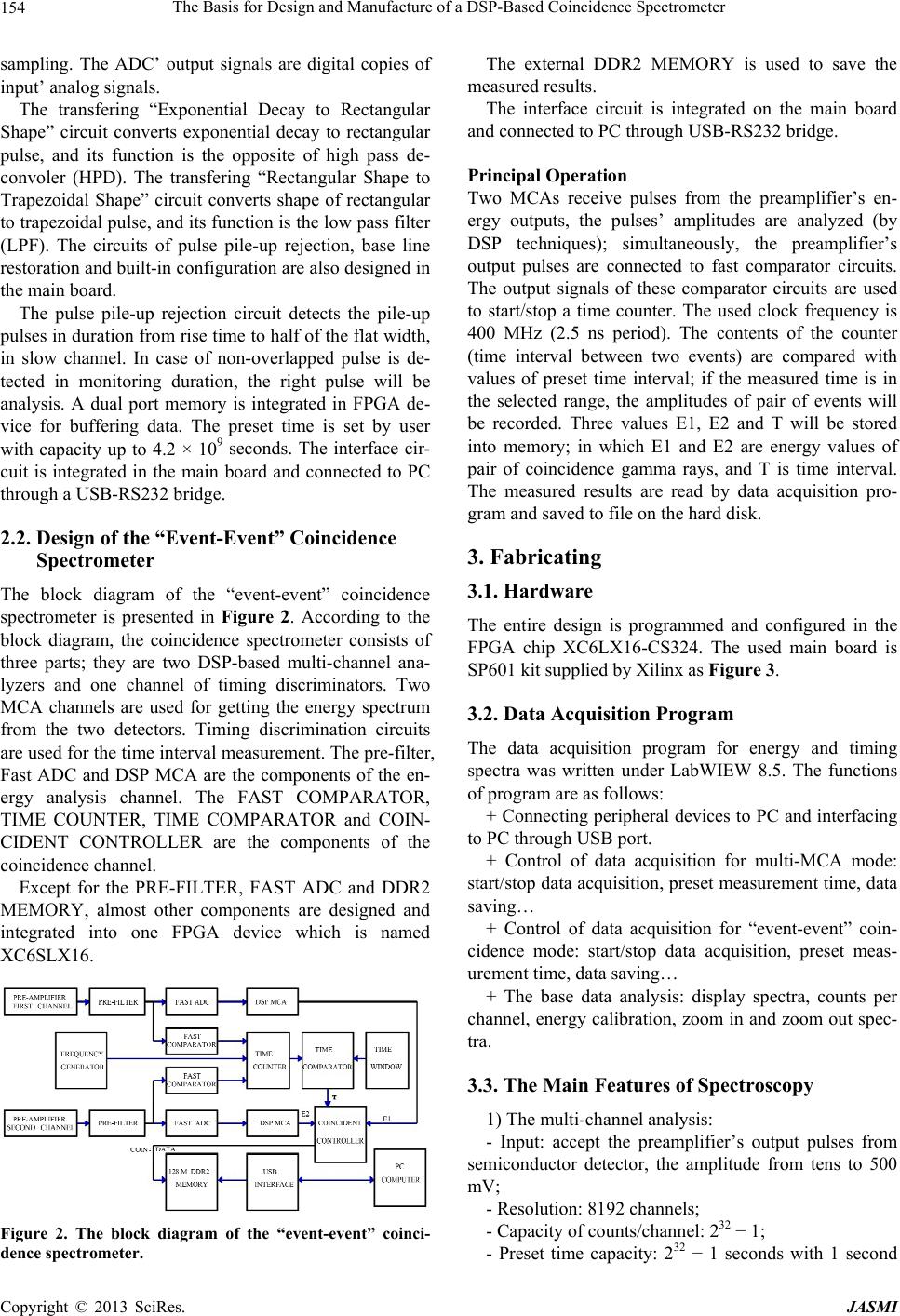
The Basis for Design and Manufacture of a DSP-Based Coincidence Spectrometer
154
sampling. The ADC’ output signals are digital copies of
input’ analog signals.
The transfering “Exponential Decay to Rectangular
Shape” circuit converts exponential decay to rectangular
pulse, and its function is the opposite of high pass de-
convoler (HPD). The transfering “Rectangular Shape to
Trapezoidal Shape” circuit converts shape of rectangular
to trapezoidal pulse, and its function is the low pass filter
(LPF). The circuits of pulse pile-up rejection, base line
restoration and built-in configuration are also designed in
the main board.
The pulse pile-up rejection circuit detects the pile-up
pulses in duration from rise time to half of the flat width,
in slow channel. In case of non-overlapped pulse is de-
tected in monitoring duration, the right pulse will be
analysis. A dual port memory is integrated in FPGA de-
vice for buffering data. The preset time is set by user
with capacity up to 4.2 × 109 seconds. The interface cir-
cuit is integrated in the main board and connected to PC
through a USB-RS232 bridge.
2.2. Design of the “Event-Event” Coincidence
Spectrometer
The block diagram of the “event-event” coincidence
spectrometer is presented in Figure 2. According to the
block diagram, the coincidence spectrometer consists of
three parts; they are two DSP-based multi-channel ana-
lyzers and one channel of timing discriminators. Two
MCA channels are used for getting the energy spectrum
from the two detectors. Timing discrimination circuits
are used for the time interval measurement. The pre-filter,
Fast ADC and DSP MCA are the components of the en-
ergy analysis channel. The FAST COMPARATOR,
TIME COUNTER, TIME COMPARATOR and COIN-
CIDENT CONTROLLER are the components of the
coincidence channel.
Except for the PRE-FILTER, FAST ADC and DDR2
MEMORY, almost other components are designed and
integrated into one FPGA device which is named
XC6SLX16.
Figure 2. The block diagram of the “event-event” coinci-
dence spectrometer.
The external DDR2 MEMORY is used to save the
measured results.
The interface circuit is integrated on the main board
and connected to PC through USB-RS232 bridge.
Principal Operation
Two MCAs receive pulses from the preamplifier’s en-
ergy outputs, the pulses’ amplitudes are analyzed (by
DSP techniques); simultaneously, the preamplifier’s
output pulses are connected to fast comparator circuits.
The output signals of these comparator circuits are used
to start/stop a time counter. The used clock frequency is
400 MHz (2.5 ns period). The contents of the counter
(time interval between two events) are compared with
values of preset time interval; if the measured time is in
the selected range, the amplitudes of pair of events will
be recorded. Three values E1, E2 and T will be stored
into memory; in which E1 and E2 are energy values of
pair of coincidence gamma rays, and T is time interval.
The measured results are read by data acquisition pro-
gram and saved to file on the hard disk.
3. Fabricating
3.1. Hardware
The entire design is programmed and configured in the
FPGA chip XC6LX16-CS324. The used main board is
SP601 kit supplied by Xilinx as Figure 3.
3.2. Data Acquisition Program
The data acquisition program for energy and timing
spectra was written under LabWIEW 8.5. The functions
of program are as follows:
+ Connecting peripheral devices to PC and interfacing
to PC through USB port.
+ Control of data acquisition for multi-MCA mode:
start/stop data acquisition, preset measurement time, data
saving…
+ Control of data acquisition for “event-event” coin-
cidence mode: start/stop data acquisition, preset meas-
urement time, data saving…
+ The base data analysis: display spectra, counts per
channel, energy calibration, zoom in and zoom out spec-
tra.
3.3. The Main Features of Spectroscopy
1) The multi-channel analysis:
- Input: accept the preamplifier’s output pulses from
semiconductor detector, the amplitude from tens to 500
mV;
- Resolution: 8192 channels;
- Capacity of counts/channel: 232 − 1;
- Preset time capacity: 232 − 1 seconds with 1 second
Copyright © 2013 SciRes. JASMI